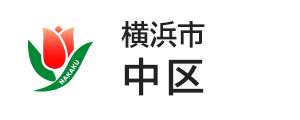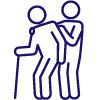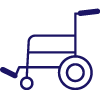Última fecha actualizada: 2024/9/25
Es el texto de aquí.
Disaster Prevention
Preparing for Disasters
Learn about disasters
Japan is an earthquake-prone country, and Yokohama City is said to be particularly susceptible to major earthquakes. You never know when an earthquake will occur. Be prepared for earthquakes on a day-to-day basis.
In addition, in recent years, heavy rain and strong winds caused by typhoons and other storms have occurred throughout Japan. To minimize any potential damage, be prepared for heavy rain and strong winds on a day-to-day basis.
⇒ Disasters (earthquakes and typhoons)
Prepare for disasters
Be prepared by finding out how to gather information, confirming measures you can take to secure your home, and preparing a stockpile necessities and emergency supplies.
⇒ Prepare for disasters
⇒ How to seek medical care in Yokohama City in the event of a disaster
Disaster risk in your region
Check the disaster risk level in your area referencing the various kinds of hazard maps.
Note: The hazard map indicates areas (in color) highly likely to be impacted by landslide or flooding. Note, however, that a disaster may still occur in places not marked with color.
●Waiwai Disaster Prevention Map
Various kinds of information to help reduce the impact of disasters (projected seismic intensity, liquefaction risk; risk for specific areas of landslide, tsunami, flooding, urban flooding, high tides, etc.)
⇒Mapa de Prevención del Desastre de Waiwai (el sitio exterior) (japonés)
●Yokohama City Sediment Disaster Map (Naka Ward)
Areas that may sustain damage due to landslides caused by heavy rains
⇒Yokohama City Sediment Disaster Map (Naka Ward)(Japanese)
●Yokohama City Urban Flooding Hazard Map (Naka Ward)
Areas where sewers, waterways, etc., are projected to flood
⇒Yokohama City Urban Flooding Hazard Map (Naka Ward)(Japanese)
●Areas subject to immediate evacuation orders
These are areas subjected to evaluation instruction along with sediment disaster alert information. There are five applicable areas in Naka Ward. Naka Office will contact people living in the areas on an individual basis.
⇒Areas subject to immediate evacuation orders(Japanese)
●Naka Ward Flood Hazard Map
Areas projected to sustain damage in the event of flooding rivers, etc.
⇒Naka Ward Flood Hazard Map(Japanese)
Nota: Check the various hazard maps on the website. The maps are also distributed at Naka Administration Office.
Note: Evacuation sites noted on the Hazard Map will be opened and made available in accordance with the scale/circumstances of a disaster.
Preparing for Earthquakes
In the event of an earthquake
⇒ How to protect yourself during a disaster
⇒ If you are in trouble when a disaster occurs while you are away from home
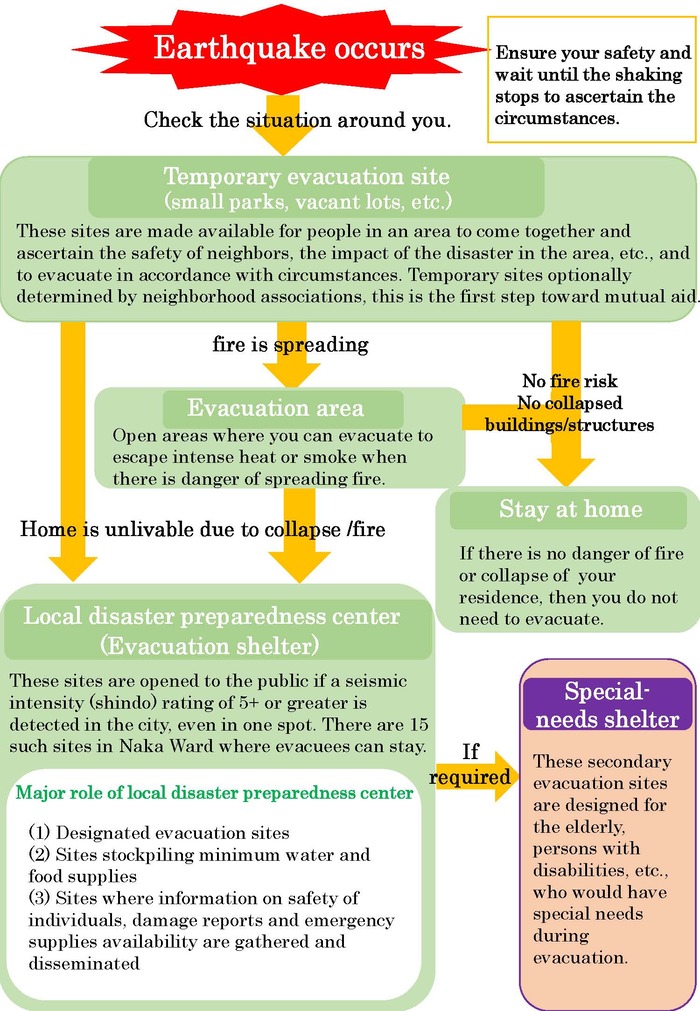
Local Disaster Preparedness Center
Nearby schools will be set up as evacuation centers and temporary shelters to be utilized by people whose homes have been damaged in an earthquake or fire. Post-earthquake evacuation sites (Local Disaster Preparedness Centers) stockpile food, beverages, daily necessities, and disaster prevention materials. Emergency supplies will also be sent to these sites in the event of an earthquake.
* Different evacuation sites are opened in the event of heavy winds or flooding.
| Facility Name | Location | Areas covered |
|---|---|---|
| Kitagata ES | 29 Suwa-cho | Yamate-cho 165-171, Ueno-cho 1&2 chome, Suwa-cho, Nishinoya-cho, Chiyozaki-cho, Kitagata-cho, Shin-Yamashita 1-3 chome |
| Motomachi ES | 36 Yamate-cho | Motomachi, Yamate-cho(except 165-171), Ueno-cho 3&4 chome, Kashiwaba, Myokojidai |
| Honcho ES | 3-86 Hanasaki-cho | Akamon-cho 1 chome, Hanabusa-cho, Hatsune-cho, Kogane-cho, Hinode-cho, Sakuragi-cho 1-3 chome, Kaigan-dori, Miyagawa-cho, Motohama-cho, Minato-cho, Sakuragi-cho 1-3 chome, Sumiyoshi-cho, Tokiwa-cho, Shinko 1&2 chome, Masago-cho, Aioi-cho, Ota-machi, Uchida-cho, Minaminaka-doru, Onoe-cho, Benten-dori, Kitanaka-dori, Noge-cho, Hon-cho, Nihon-odori, Yokohama-Koen |
| Tateno ES | 76 Tateno | Sagiyama, Yamato-cho, Takenomaru, Mugita-cho, Tateno |
| Otori ES | 1-251 Honmoku-cho | Kominato-cho, Hongo-cho, Honmoku-Arai(131, 132, 151, 158, 170, 303), Honmoku-Juniten, Honmoku-cho, Honmoku-Manzaka, Honmoku-Midorigaoka, Wadayama |
| Yamamoto ES | 3-152 Yamamoto-cho | Negishidai, Negishi-Asahidai, Yamamoto-cho, Terakubo, Nishi-Takenomaru, Oshibadai, Ohira-cho, Tsukagoshi, Minosawa, Takinoue (except 51-78) |
| Makado ES | 29-1 Honmoku-Makado | Negishi-cho, Chidori-cho, Honmoku-Makado, Honmoku-Arai (except 131, 132, 151, 158, 170, 303), Honmoku-Sannotani, Honmoku-Osato-cho, Negishi-Kazodai, Ikebukuro |
| Honmoku-Minami ES | 44-1 Honmoku-Motomachi | Kamome-cho, Nishiki-cho, Toyoura-cho, Honmoku-Motomachi, Honmoku-Futo, Minami-Honmoku |
| Honmoku ES | 5-1 Honmoku-Wada | Honmoku-Hara, Honmoku-Wada, Honmoku-Miyabara |
| Minato JS | 241 yamashita-cho | Yamashita-cho |
| Yokohama Yoshida JS | 3-84 Hagoromo-cho | Isezaki-cho, Hagoromo-cho, Yoshida-machi, Wakaba-cho, Akebono-cho, Choja-machi 5-9 chome, Fukutomi-cho-Nishidori, Fukutomi-cho-Nakadori, Fukutomi-cho-Higashidori, Horai-cho, Sueyoshi-cho, Suehiro-cho, Yayoi-cho |
| Minato Sogo HS | 231 Yamashita-cho | Ishikawa-cho, Uchikishi |
| Nakaodai JS | 23 Nakaodai | Takinoue 51-78, Nakaodai, Mameguchidai, Yaguchidai |
| Former Fujimi JS | 3-9 Yamada-cho | Okina-cho, Yoshihama-cho, Miyoshi-cho, Yamabuki-cho, Yamada-cho, Kotobuki-cho, Matsukage-cho, Chitose-cho, Ogi-cho, Choja-machi 1-4 chome, Furo-cho, Fujimi-cho, Bandai-cho |
Kanagawa Labor Plaza | 1-4 Kotobuki-cho | Kotobuki-cho, Ogi-cho, Matuskage-cho, a part of Miyoshi-cho |
Evacuation Area
To protect yourself in the event of a major fire, evacuate to a safety Evacuation Area.
●Evacuation Area Name
・Honmoku-Sancho Koen region
・Negishi Forest Park and Negishi U.S. Naval Housing district
・Minatonomieru-Oka Park
・ Momijigaoka region
・ Nogeyama Park
⇒NAKA-KU Ward Resident Life Activity Map
Evacuating during a tsunami event
Key points to evacuating during a tsunami event
◎Evacuate to higher ground faster
When evacuating, get to a place:
・At least five meters above sea level
・On the third floor or higher of ferroconcrete buildings that can withstand shaking during an earthquake.
◎Do not drive your car to evacuate
Do not evacuate with your car (except in cases where you are assisting some with difficulty walking or other extraordinary circumstances). Large numbers of people evacuating by car can cause tariff jams and impede the evacuation process.
Preparing for heavy rain or typhoon
What to do in the event of heavy rain or typhoon

¿Dónde evacuo? - evacuan para salvar su vida

●Evacuate to a safe location
Evacuate to an evacuation site, to nearby high ground, or to the home of a relative in a location not subjected to landslide or potential flood alert.
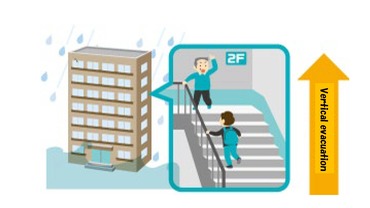
●Evacuate to the second floor or higher of a robust building or to a nearby tall building.

●Take shelter in a safe place inside a building.
If it is more dangerous to evacuate outdoors, instead take shelter on upper floors of your home, the other side of a cliff, etc.
Even when no evacuation information has been issued, you can take other actions if you feel danger.
Evacuation sites in the event of storm and flooding damage/ warning levels
●Warning Level
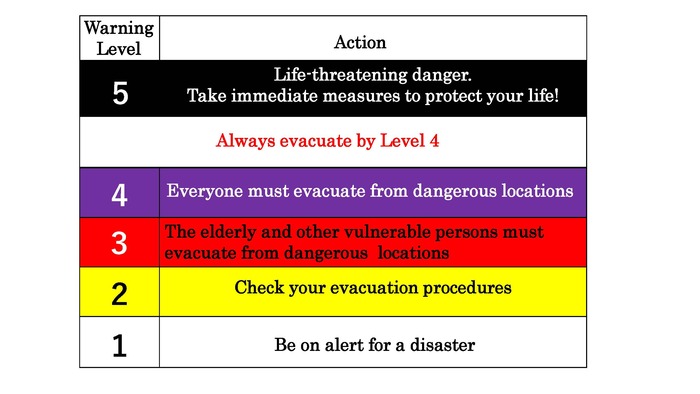
●Evacuation sites
At Warning Level 3, evacuation sites will be opened for people located near cliffs/slopes, etc.
・Mugita Seifuso : 1-26-1 Mugita-cho
・Yamamoto ES: 3-152 Yamamoto-cho
・Otori ES: 1-251 Honmoku-cho
・Kamidai Shukaijo: 2-50 Hongo-cho
・Minato Sogo HS: 231 Yamashita-cho
Note: Additional evacuation sites will be opened in accordance with disaster circumstances.
These sites differ from the evacuation shelters that open following an earthquake with a seismic intensity (shindo) of 5+ or higher.
Page ID: 285-365-330
